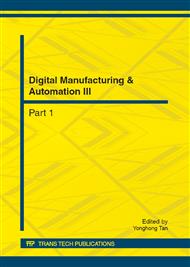[1]
W. Wang, K. Wang. "Geometric modeling for swept volume of moving solids". IEEE Computer Graphics and Applications, 1986, 6(2), pp.8-17.
DOI: 10.1109/mcg.1986.276586
Google Scholar
[2]
R. Martin, P. Stephenson. "Sweeping of three-dimensional objects". Computer-Aided Design, 1990, 22(4), pp.223-234.
DOI: 10.1016/0010-4485(90)90051-d
Google Scholar
[3]
K. Malek, H. Yeh. "Geometric representation of the swept volume using Jacobian rank-deficiency conditions". Computer-Aided Design, 1997, 29(6), pp.457-468.
DOI: 10.1016/s0010-4485(96)00097-8
Google Scholar
[4]
Y. Chung, J. Park, H. Shin, B. Choi. "Modeling the surface swept by a generalized cutter for NC-verification". Computer-Aided Design, 1998, 30(8), pp.587-594.
DOI: 10.1016/s0010-4485(97)00033-x
Google Scholar
[5]
C. Chiou, Y. Lee. "Swept surface determination for five-axis numerical control machining". International Journal of Machine Tools and Manufacture, 2002, 42(14), pp.1497-1507.
DOI: 10.1016/s0890-6955(02)00110-4
Google Scholar
[6]
K. Weinert, S. Du, P. Damm, M. Stautner. "Swept volume generation for the simulation of machining processes". International Journal of Machine Tools and Manufacture, 2004, 44(6), pp.617-628.
DOI: 10.1016/j.ijmachtools.2003.12.003
Google Scholar
[7]
Y. Kim, G. Varadhan, M. Lin, D. Manocha. "Fast swept volume approximation of complex polyhedral models". Solid Modeling Theory and Applications, 2004, 36(11), pp.1013-1027.
DOI: 10.1016/j.cad.2004.01.004
Google Scholar
[8]
J. Yang, K. Malek. "Approximate swept volumes of NURBS surfaces or solids". Computer Aided Geometric Design, 2005, 22(1), pp.1-26.
DOI: 10.1016/j.cagd.2004.08.002
Google Scholar
[9]
S. Du, T. Surmann, O. Webber, K. Weinert. "Formulating swept profiles for five-axis tool motions". International Journal of Machine Tools and Manufacture, 2005, 45(7-8), pp.849-861.
DOI: 10.1016/j.ijmachtools.2004.11.006
Google Scholar
[10]
L. Zhu, G. Zheng, X. Zhang, H. Ding. Modeling the surface swept by a milling cutter by using the envelope theory of two-parameter family of spheres. Journal of Mechanical Engineering, 46(5)(2010) 145-149.
DOI: 10.3901/jme.2010.05.145
Google Scholar
[11]
J. Yang, X. Du, K. Huang, B. Wang, F. Peng. Milling cutter swept volume modeling and cutting simulation based on velocity anisotropy of cutter surface. China Mechanical Engineering, 22(21)(2011) 2593-2597.
Google Scholar
[12]
S. Lee, A. Nestler. Complete swept volume generation, Part I: Swept volume of a piecewise C1-continuous cutter at five-axis milling via Gauss map. Computer-Aided Design, 43(4)(2011) 427-441.
DOI: 10.1016/j.cad.2010.12.010
Google Scholar


